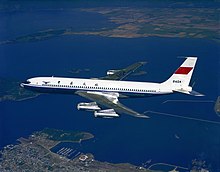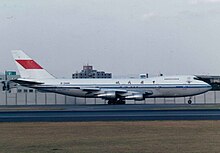CAAC Airlines
 | |||||||
| |||||||
| Founded | 1952 (as the People's Aviation Company of China) 1953 (as CAAC) | ||||||
|---|---|---|---|---|---|---|---|
| Commenced operations | 1950 | ||||||
| Ceased operations | 1988 (split into six airlines) | ||||||
| Hubs | Beijing Capital Shanghai Hongqiao Guangzhou Baiyun Chengdu Shuangliu Xi'an Xiguan Shenyang Taoxian | ||||||
| Destinations | 85 cities in 25 countries (1987) | ||||||
| Parent company | State Council | ||||||
| Headquarters | Beijing, China | ||||||
| Key people | Director of the General Office | ||||||
CAAC Airlines (Chinese: 中国民航), formerly the People's Aviation Company of China (中國人民航空公司), was the airline division of the Civil Aviation Administration of China (CAAC) and the monopoly civil airline in the People's Republic of China. It was founded on July 17, 1952, and merged into CAAC on June 9, 1953. In 1988, the monopoly was broken up and CAAC Airlines was split into six regional airlines, which later consolidated into China's Big Three airlines: Beijing-based Air China, Guangzhou-based China Southern Airlines, and Shanghai-based China Eastern Airlines.
In 1962, CAAC began operating international services, initially to other countries in the communist bloc such as the Soviet Union, Mongolia, North Korea, Laos, Burma, Bangladesh, North Vietnam, and Cambodia.[1] By the mid-1980s, CAAC had long-haul service to the United States, Europe, the Middle East, and Australia, mainly using American Boeing aircraft, while continuing to use Soviet aircraft on routes to Eastern Europe.[2]
Separation[]
In 1988, CAAC Airlines split into six separate airlines, each named after the geographic region of their main operating areas:
- Air China, the flag carrier, based in Beijing, inherited the IATA and ICAO code of CAAC; subsidiary Dalian Airlines was launched in 2011
- China Southwest Airlines, based in Chengdu (merged into Air China in 2002); Chengdu-based parent Sichuan Airlines was launched in 1986, while subsidiary Chengdu Airlines was launched in 2011
- China Eastern Airlines, based in Shanghai, along with subsidiary Shanghai Airlines
- China Northwest Airlines, based in Xi'an (merged into China Eastern in 2002)
- China Southern Airlines, based in Guangzhou
- China Northern Airlines, based in Shenyang (merged into China Southern in 2003)
CAAC used the IATA code CA on international flights only; domestic flights were not prefixed with the airline code.
CAAC aircraft livery featured Chinese national flag on the vertical stabilizer, with blue stripes and Chinese version of CAAC logo (designed by Lu Shifang in 1965,[3] with the calligraphy of Premier Zhou Enlai) on a white fuselage.
Fleet[]


CAAC's fleet in 1988[]
Before dissolution in 1988 the fleet of CAAC Airlines consisted of:[5]
- Airbus A310
- Antonov An-12
- Antonov An-24
- Antonov An-26
- Antonov An-30
- BAe 146-100
- Boeing 707
- Boeing 737
- Boeing 747
- Boeing 757
- Boeing 767
- Hawker Siddeley Trident 2E
- Ilyushin Il-18
- Ilyushin Il-62
- Lockheed L-100 Hercules
- McDonnell Douglas MD-82
- Short 360
- Tupolev Tu-154B
- Tupolev Tu-154M
- Vickers Viscount
- Xian Y-7, Y-7-100
- Yakovlev Yak-42
General aviation[]
- Aérospatiale Alouette SA-319
- Antonov An-2
- Bell 212
- Bell 214ST
- Boeing 234
- Harbin Y-11
- Harbin Z-5
- MBB Bo 105
- Mil Mi-8
- Shijiazhuang Y-5
Fleet retired before 1987[]
- Ilyushin Il-14 (Left service in 1982)
- Lisunov Li-2 (Left service in 1980)
- Vickers Viscount (Left service in 1984)
Major incidents[]
- On 5 April 1958, Ilyushin Il-14 632 crashed 70 km (43 mi) from Xi'an while operating a Chengdu–Xi'an–Taiyuan–Beijing passenger flight, killing all 14 on board.[6]
- On 26 September 1961, Shijiazhuang Y-5 18188 crashed into Qinglongshan (Blue Dragon Mountain), Henan Province, killing all 15 on board.[7]
- On 15 February 1966, Shijiazhuang Y-5 18152 struck a mountain in Gansu Province in poor visibility; both pilots survived.[8]
- On 5 December 1968, Ilyushin Il-14 640 crashed 1209 meters south of Beijing Capital International Airport when landing, killing 10 people on board, including scientist Guo Yonghuai.[9]
- In 1969, Ilyushin Il-14 618 crashed at Guiyang.[10]
- On 14 November 1970, Ilyushin Il-14 616 struck a mountain near Guiyang, killing six.[11]
- In May 1972, a CAAC Lisunov Li-2 overshot the runway at Dalian Zhoushuizi Airport, killing six.[citation needed]
- On 14 January 1973, Ilyushin Il-14 644 struck a mountain near Guiyang, killing all 29 on board.[12]
- On 21 January 1976, a CAAC Antonov An-24 B-492 crashed on approach to Changsha Huanghua Airport, killing all 40 on board.[13]
- On 26 August 1976, a CAAC Ilyushin Il-14 crashed during landing in Chengdu, killing 12 passengers.[citation needed]
- On 14 March 1979, a CAAC Hawker Siddeley Trident 2E B-274 crashed into a factory in Beijing on climbout from Xijiao Airport during a training flight, killing all 12 on board and 32 on the ground.[14]
- On 20 March 1980, a CAAC Antonov An-24RV B-484 crashed and burned near Changsha Huanghua Airport, killing all 26 on board.[15]
- On 26 April 1982, CAAC Flight 3303, a Hawker Siddeley Trident 2E (B-266), crashed into a mountain near Yangshuo while on approach to Guilin, killing all 112 on board.
- On 25 July 1982, CAAC Flight 2505, an Ilyushin Il-18V (B-220), was hijacked en route from Xi'an to Shanghai. The co-pilot and navigator were wounded and a bomb exploded when passengers overpowered the hijackers. The aircraft landed at Shanghai with two engines flamed out.[16][17]
- On 24 December 1982, CAAC Flight 2311, an Ilyushin Il-18B (B-202), burst into flames while landing at Guangzhou Baiyun Airport, killing 25 of 69 on board.[18]
- On 5 May 1983, CAAC Flight 296, a Hawker Siddeley Trident 2E (B-296), was hijacked while en route from Shenyang Dongta Airport to Shanghai Hongqiao International Airport and landed at the US Army base Camp Page in South Korea. The incident marked the first direct negotiations between South Korea and China, which did not have formal relations at the time.[19]
- On 14 September 1983, CAAC Flight 264, a Hawker Siddeley Trident 2E B-264 collided with a Harbin H-5 bomber while taxiing at Guilin Qifengling Airport. 11 of 106 on board were killed.[20]
- On 25 June 1984, a CAAC aircraft was hijacked by a man armed with hand grenades and demanded to be flown to Taiwan. A passenger overpowered the hijacker and the aircraft continued to Fuzhou.[21]
- On 18 January 1985, CAAC Flight 5109, an Antonov An-24B (B-434), crashed in drizzle and fog while performing a missed approach to Jinan, killing 38 of 41 on board.[22]
- On 22 October 1985, a CAAC Shorts 360-100 (B-3606) was written off after overrunning the runway on landing at Enshi Airport; all 25 on board survived.[23]
- On 15 December 1986, a CAAC Antonov An-24RV (B-3413) crashed while attempting to return to Lanzhou after an engine failed due to icing, killing 6 of 44 on board.[24]
- On 16 June 1987, a CAAC Boeing 737-2T4 (B-2514) collided with a Shenyang J-6 at Fuzhou Airport; the J-6 crashed, killing the pilot while the 737 landed safely.[25]
- On 31 August 1988, CAAC Flight 301, a Hawker Siddeley Trident 2E (B-2218), struck approach lights at Kai Tak Airport and struck a lip, collapsing the right main landing gear; the aircraft then slid off the runway into Kowloon Bay, killing 7 of the 89 on board. The cause was undetermined, but windshear may have been a factor.[26]
References[]
- ^ 1964 timetable scans Archived June 3, 2016, at the Wayback Machine
- ^ 1985 route map Archived March 4, 2016, at the Wayback Machine
- ^ "成立军委民航局 - 中国民航局60周年档案展". CAAC. Retrieved 20 February 2021.
- ^ B-2448 was handed over to Air China in 1987.
- ^ Klee, Ulrich & Bucher, Frank et al.: jp airline-fleets international 88. Zürich-Airport 1988, p. 10–13.
- ^ Accident description for 632 at the Aviation Safety Network. Retrieved on 25 August 2014.
- ^ Accident description for 18188 at the Aviation Safety Network. Retrieved on 21 January 2013.
- ^ Accident description for 18152 at the Aviation Safety Network. Retrieved on 21 January 2013.
- ^ 北京市地方志编纂委员会 (2000). 北京志·市政卷·民用航空志. 北京出版社. p. 288. ISBN 7-200-04040-1.
- ^ Accident description for 618 at the Aviation Safety Network
- ^ Accident description for 616 at the Aviation Safety Network. Retrieved on 27 April 2018.
- ^ Accident description for 644 at the Aviation Safety Network. Retrieved on 25 August 2014.
- ^ Accident description for B-492 at the Aviation Safety Network. Retrieved on 21 January 2013.
- ^ Accident description for B-274 at the Aviation Safety Network. Retrieved on 21 January 2013.
- ^ Accident description for B-484 at the Aviation Safety Network. Retrieved on 25 August 2014.
- ^ Accident description at the Aviation Safety Network. Retrieved on 28 December 2017.
- ^ 《陕西省志·民航志》编纂委员会 (2001). 陕西省志·民航志 (in Chinese). 西��地图出版社. p. 191. ISBN 7-80670-007-2.
- ^ Accident description for B-202 at the Aviation Safety Network. Retrieved on 21 January 2013.
- ^ Hijacking description for B-296 at the Aviation Safety Network. Retrieved on 21 January 2013.
- ^ Accident description for B-264 at the Aviation Safety Network. Retrieved on 21 January 2013.
- ^ Hijacking description at the Aviation Safety Network
- ^ Accident description for B-434 at the Aviation Safety Network. Retrieved on 21 January 2013.
- ^ Accident description for B-3606 at the Aviation Safety Network
- ^ Accident description for B-3413 at the Aviation Safety Network. Retrieved on 21 January 2013.
- ^ Accident description for B-2514 at the Aviation Safety Network. Retrieved on 2016-6-30.
- ^ Accident description for B-2218 at the Aviation Safety Network. Retrieved on 2017-09-04.
- Former monopolies
- Companies based in Beijing
- Defunct airlines of China
- Transportation monopolies
- Airlines established in 1949
- Airlines disestablished in 1988
- Government-owned companies of China
- Civil Aviation Administration of China
- Chinese companies established in 1949
- Chinese companies disestablished in 1988
